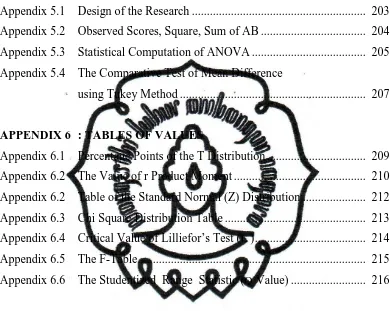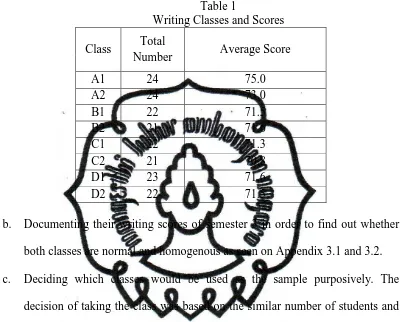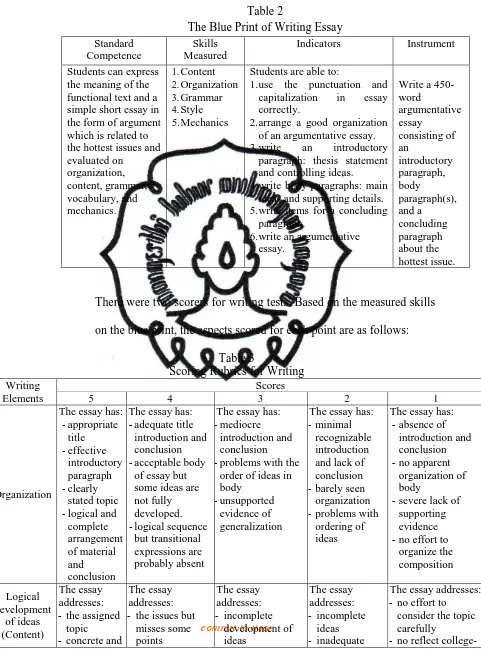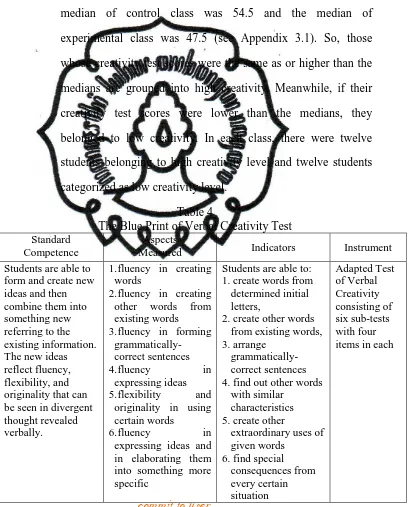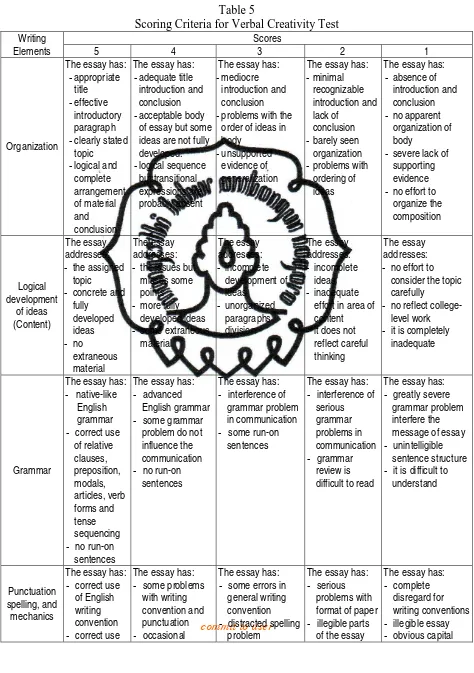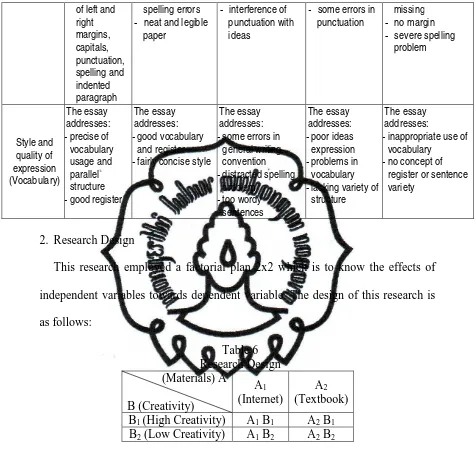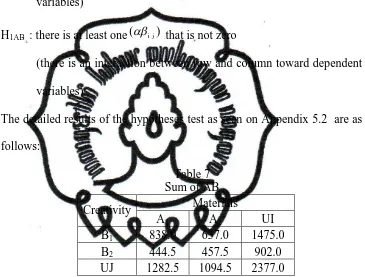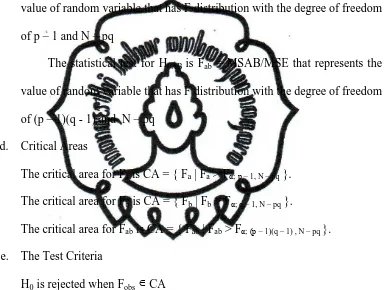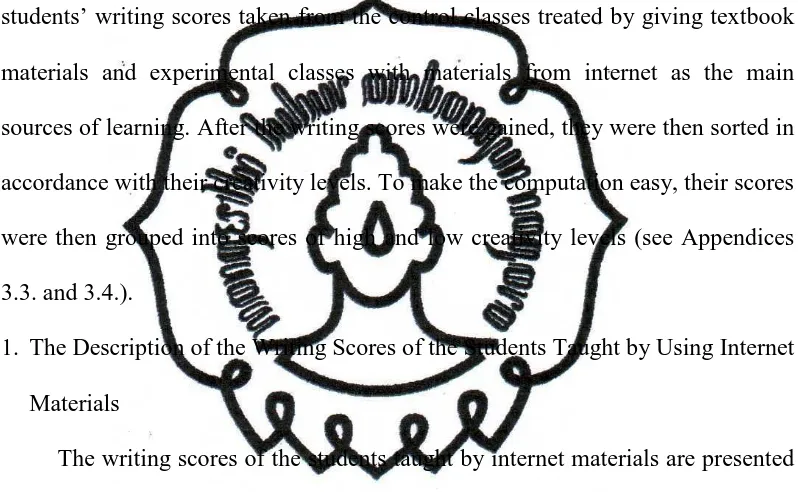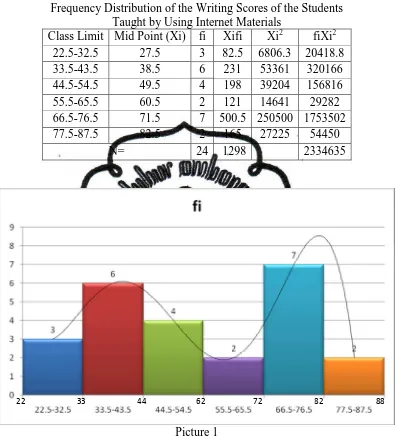THE EFFECTIVENESS OF INTERNET-BASED MATERIALS
TO TEACH WRITING VIEWED FROM STUDENTS’ CREATIVITY
(An Experimental Research in the Semester Four Students of the English
Department, Teacher Training and Education Faculty, Muhammadiyah University of
Purwokerto, in the Academic Year of 2009/2010)
Thesis
Written to Fulfill One of the Requirements
to Get the Graduate Degree in English Education
Written by:
Fais al
THE EFFECTIVESS OF INTERNET-BASED MATERIALS
TO TEACH WRITING VIEWED FROM STUDENTS’ CREATIVITY
(An Experimental Research in the Semester Four Students of the English
Department, Teacher Training and Education Faculty, Muhammadiyah University of
Purwokerto, in the Academic Year of 2009/2010)
By:
Fais al
NIM S. 890908114
Approved by Consultants
Date :...
Consultant I
Dr. Ngadiso, M.Pd NIP. 196212311988031009
Consultant II
Dr. Abdul Asib, M.Pd. NIP. 195203071980031005
The Head of the English Education Department
LEGITIMATION FROM THE BOARD OF EXAMINERS
THE EFFECTIVESS OF INTERNET-BASED MATERIALS TO TEACH WRITING VIEWED FROM STUDENTS’ CREATIVITY
(An Experimental Research in the Semester Four Students of the English Department, Teacher Training and Education Faculty, Muhammadiyah University of
Purwokerto, in the Academic Year of 2009/2010)
By FAISAL
This Thesis has been examined by the board of Thesis examiners and approved as a fulfilment of the requirements of obtaining Graduate Degree in
English Education Department of Sebelas Maret University
On: August 9, 2010
By:
Board of Thesis Examiners: Signature
Head : Prof. Dr. Joko Nurkamto,M.Pd. ___________________ NIP. 19610124198702 1 001
Secretary : Dr. Sujoko ___________________
NIP 1951091201980031002
Members : 1. Dr. Ngadiso, M. Pd. ___________________ NIP 196212311988031009
PRONOUNCEMENT
This is to certify that I myself write this thesis entitled “The Effectiveness of
Internet-Based Materials to Teach Writing Viewed from Students’ Creativity
(An Experimental Research in the Semester Four Students of the English
Department, Teacher Training and Education Faculty, Muhammadiyah University of
Purwokerto in the Academic Year of 2009/2010)”. It is not a plagiarism or made by
others. Anything related to others’ work is written in quotation, the source of which
is listed on the bibliography.
If then this pronouncement proves wrong, I am ready to accept any academic
consequences, including the withdrawal or cancelation of my academic degree.
Surakarta, July , 2010
ABSTRACT
Faisal, S.890908114: The Effectiveness of Internet-based Materials to Teach Writing
Viewed from Students’ Creativity (an Experimental Research in the Semester Four
Students of the English Department, Teacher Training and Education Faculty, Muhammadiyah University of Purwokerto, in the Academic Year of 2009/2010). First Consultant: Dr. Ngadiso, M.Pd.; Second Consultant: Dr. A. Asib, M.Pd., Thesis, Surakarta, English Department, Graduate School, Sebelas Maret University Surakarta, 2010.
The main objectives of the research are to know whether: (1) internet materials are more effective than textbook ones in teaching writing for the fourth semester students of the English Department of Teacher Training and Education Faculty, Muhammadiyah University of Purwokerto; (2) the fourth semester students having high level of creativity have better writing competence than those having level of creativity; and (3) there is an interaction effect between teaching materials and creativity in teaching writing for the fourth semester students for teaching writing.
The experimental method was employed in this research. The population of the research was the fourth semester students of the English Department, Faculty of Teacher Training and Education, Muhammadiyah University of Purwokerto in the Academic Year of 2009/2010. The sampling technique used was Cluster Sampling. The sample in the research was 48 students covering 24 students of A2 as the experimental class and 24 students of A1 as the control class. The research instruments consist of an adapted Munandar’s Verbal Creativity Test and writing test about argumentative essay which was designed by the researcher. Before the instruments were used, a try-out was done to know the validity and reliability of the instrument. After treatment was given in eight meetings, the researcher conducted a post-test to get the research data. Having got research data, the researcher analyzed the data in terms of their frequency distribution, normality of the sample distribution, and data homogeneity. Then, researcher used ANOVA test (multifactor analysis of variance) and TUKEY test to test the research hypotheses.
MOTTO
1. Proclaim! (or read!) in the name of thy Lord and Cherisher, Who Created.
Created man, out of a (mere) clot of congealed blood. Proclaim! And thy Lord is
Most Bountiful. He who taught (the use of) the pen. Taught man that which he
knew. (Al-Alaq, 1-5).
2. Allah, the Mighty, says: “When I afflict the two beloved faculties (eyes) of a
worshiper of Mine, and he remains patient with his affliction, in their place I will
give him Paradise” (Al Hadith).
3. “Whatever trouble, illness, anxiety, grief, hurt, or sorrow that afflicts a Muslim,
even the prick of a thorn, Allah removes in its place some of his sins”
DEDICATION
This is thesis is dedicated to
ACKNOWLEDGEMENT
First of all, the writer prays to Allah SWT., the God Almighty that he can
finally finish this thesis as a partial fulfilment of the requirements for the Graduate
Degree of Education in English.
In doing this work, the writer realizes that he is unable to finish it without
contributions, helps, suggestions, and comments from many people. He is greatly
indebted to them. Therefore, in this opportunity he would like to express his gratitude
to:
1. The Director of Graduate School of Sebelas Maret University for his permission
to write this thesis,
2. The Head of the English Education Department, Graduate School of Sebelas
Maret University who has suggested and guided the writer to do this thesis well,
3. Dr. Ngadiso, M.Pd., his first consultant, whose patience, attention, kindness,
time, criticism, and correction absolutely have encouraged the writer to do his
best,
4. Dr. A. Asib, M.Pd., the second consultant, who thoroughly and patiently has
given the writer guidance and valuable ideas for the perfection of this thesis,
5. The Head of the English Department, Faculty of Teacher Training and Education,
Muhammadiyah University of Purwokerto, who has given the writer permission
to conduct the research at that department,
6. All lecturers of the English Education Department, Faculty of Teacher Training
and Education, Muhammadiyah University of Purwokerto, whose supports and
assistance have made the writer strong, patient, and persistent,
9. His best friends – Palgunawan, S.Pd., Ibu Pal, and Zaki, Hadi Wiyono, S.Pd., Ibu
Hadi and De’ Anggi, Kamal Muchtar, S.Pd. and Mba Nana, Budhi Remawan,
S.S. and Hevy, and finally, Ery Retno Wulandary, S.S. for their togetherness,
companion, cooperation, and abundant support,
10.Mas Aminuddin Noor and Mba Fitri for their invaluable assistance,
11.PT Griya Komunikasi, teachers, and staffs of LBPP LIA Purwokerto, thank you
very much for everything,
12.The fourth semester students of classes A1 and A2 of the English Department,
Muhammadiyah University of Purwokerto to whom the writer owes a lot,
13.Om Totok, Om Potro, Lek Sanah, and Lek Oto for everything you all give him.
Nothing is perfect except Allah SWT, and neither is this thesis. In the
hope to improve this thesis, all supporting suggestion and criticism are openly
welcome. Finally, the writer does hope that this thesis will be able to give useful
contribution and ideas to improve the English teaching learning process.
Surakarta, July 2010
TABLE OF CONTENT
PAGE OF TITLE ... i
PAGE OF APPROVAL ... ii
PAGE OF LEGALIZATION ... iii
PRONOUNCEMENT ... iv
ABSTRACT ... v
MOTTO ... vi
DEDICATION ... vii
ACKNOWLEDGEMENT ... viii
TABLE OF CONTENT ... x
LIST OF TABLES ... xii
LIST OF PICTURES ... xiv
LIST OF APPENDICES ... xv
CHAPTER I. INTRODUCTION A. Background of the Study ... 1
B. Problem Identification ... 6
C. Problem Limitation ... 7
D. Problem Statement ... 8
E. Objective of the Research ... 9
F. Benefit of the Research ... 9
CHAPTER II. REVIEW OF RELATED LITERATURE A. Theoretical Description ... 11
1. Writing ... 11
2. Internet Materials ... 31
CHAPTER III. RESEARCH METHODOLOGY
A. Place and Time of the Research ... 54
B. Research Method ... 55
C. Population, Sample, and Sampling ... 56
D. Technique of Collecting the Data ... 59
E. Technique of Analyzing the Data ... 69
CHAPTER IV RESULTS AND DISCUSSION A. Description of Data ... 80
B. Testing Hypotheses ... 92
1. Normality ... 92
2. Homogeneity ... 94
C. Test of Hypotheses Using Two-way ANOVA with the Same Cells ... 94
D. Discussion of Data Analysis ... 100
E. Limitation of the Research ... 103
CHAPTER V CONCLUSION, IMPLICATION, AND SUGGESTION A. Conclusion ... 105
B. Implication ... 106
C. Suggestion ... 106
BIBLIOGRAPHY ... 107
LIST OF TABLES
Table 1 Writing Classes and Scores ... 58
Table 2 The Blue Print of Writing Test ... 60
Table 3 Scoring Rubrics for Writing Test ... 60
Table 4 The Blue Print of Verbal Creativity Test ... 63
Table 5 Scoring Criteria for Verbal Creativity Test ... 64
Table 6 Research Design ... 65
Table 7 Sum of AB ... 74
Table 8 The Summary of Two-way Variance Analysis with the Same Cells ... 77
Table 9 The Writing Scores of the Students Taught by Using Internet Materials ... 80
Table 10 The Frequency Distribution of the Writing Scores of the Students Taught by Using Internet Materials... 81
Table 11 The Writing Scores of the Students Taught by Using Textbook Materials... 82
Table 12 The Frequency Distribution of the Writing Scores of the Students Taught by Using Textbook Materials ... 82
Table 13 The Writing Scores of the Students Having High Creativity and Taught by Using Internet Materials... 83
Table 14 The Frequency Distribution of the Writing Scores of the Students Having High Creativity Level and Taught by Using Internet Materials... 84
Table 15 The Description of the Writing Scores of the Students
Having Low Creativity Level and
Taught by Using Internet Materials... 86
Table 18 The Frequency Distribution of the Writing Scores of the Students Having Low Creativity Level and Taught by Using Internet Materials... 87
Table 19 The Description of the Writing Scores of the Students Having Low Creativity Level and Taught by Using Textbook Materials ... 88
Table 20 The Frequency Distribution of the Writing Scores of the Students Having Low Creativity Level and Taught by Using Textbook Materials ... 88
Table 21 The Description of the Writing Scores of the Students Having High Creativity Level ... 89
Table 22 Frequency Distribution of the Writing Scores of the Students Having High Creativity Level ... 90
Table 23 The Descriptions of the Writing Scores of the Students Having Low Creativity Level ... 91
Table 24 Frequency Distribution of the Writing Scores of the Students Having Low Creativity Level ... 91
Table 25 The Summary of Normality Test using Lilliefors ... 93
Table 26 The Summary of Homogeneity Test of Variance ... 94
Table 27 The Summary of the Mean Scores ... 95
Table 28 The Summary Result of Two-Way ANOVA with the Same Cell ... 95
Table 29 The Mean Scores of Each Cell ... 98
LISTS OF PICTURES
Picture 1 Histogram and Polygon of the Writing Scores of the Students
Taught by Using Internet Materials ... 81
Picture 2 Histogram and Polygon of the Writing Scores of the Students
Taught by Using Textbook Materials ... 82
Picture 3 Histogram and Polygon of the Writing Scores of the Students
Having High Creativity Level and Taught by Using Internet
Materials... 84
Picture 4 Histogram and Polygon the Writing Scores of the Students
Having High Creativity Level and Taught by Using Textbook
Materials... 86
Picture 5 Histogram and Polygon of the Writing Scores of the Students
Having Low Creativity Level and Taught by
Using Internet Materials... 87
Picture 6 Histogram and Polygon of the Writing Scores of the Students
Having Low Creativity Level and Taught by
Using Textbook Materials ... 89
Picture 7 Histogram and Polygon of the Writing Scores of the Students
Having High Creativity Level ... 90
Picture 8 Histogram and Polygon of the Writing Scores of the Students
LISTS OF APPENDICES
APPENDIX 1 : RESEARCH INSTRUMENT
Appendix 1.1 Lesson Plans of Control Class ... 111
Appendix 1.2 Lesson Plans of Experimental Class ... 126
Appendix 1.3 The Blue Print of the Writing Essay ... 143
Appendix 1.4 Instruction of the Writing Test ... 144
Appendix 1.5 Validation of Writing Test ... 145
Appendix 1.6 Validity and Reliability of Creativity Test ... 147
Appendix 1.7 Adapted and Modified Verbal Test... 150
APPENDIX 2 : RESULTS OF INSTRUMENT TEST Appendix. 2.1 Balance Test Between Control and Experimental Class based on the Writing Scores of Semester Three ... 151
APPENDIX 3 : RESULTS OF THE RESEARCH Appendix 3.1 The Level of Creativity of the Experimental Class ... 153
Appendix 3.2 The Level of Creativity of the Control Class ... 154
Appendix 3.3 The Result of the Writing Scores of the Students Taught by Using Internet Materials, Creativity Scores, and the Frequency Distribution ... 155
Appendix 3.4 The Result of the Writing Scores of the Students Taught by Using Textbook Materials, Creativity Scores, and the Frequency Distribution ... 159
the Students Having Low Creativity Level
and Taught by Using Internet Materials ... 169
Appendix 3.8 Frequency Distribution of the Writing Scores of
the Students Having Low Creativity Level and Taught
by using Textbook Materials ... 172
Appendix 3.9 Frequency Distribution of the Writing Score of the Students
Having High Creativity Level ... 175
Appendix 3.10 Frequency Distribution of the Writing Score of the Students
Having Low Creativity Level ... 179
APPENDIX 4 : TESTING HYPOTHESES
Appendix 4.1. Normality of the Writing Score of the Students
Taught by Using Internet Materials ... 183
Appendix 4.2 Normality of the Writing Score of the Students
Taught by Using Textbook Materials ... 185
Appendix 4.3 Normality of the Writing Scores of the Students
Having High Creativity Level and Taught by Using
Internet Materials ... 187
Appendix 4.4 Normality of the Writing Score of the Students
Having High Creativity Level and Taught by Using
Textbook Materials ... 189
Appendix 4.5 Normality of the Writing Score of the Students
Having Low Creativity Level and Taught by Using
Internet Materials ... 191
Appendix 4.9 Homogeneity Test ... 199
Appendix 4.10 Balance Test ... 201
APPENDIX 5 : RESULTS OF ANOVA Appendix 5.1 Design of the Research ... 203
Appendix 5.2 Observed Scores, Square, Sum of AB ... 204
Appendix 5.3 Statistical Computation of ANOVA ... 205
Appendix 5.4 The Comparative Test of Mean Difference using Tukey Method ... 207
APPENDIX 6 : TABLES OF VALUES Appendix 6.1 Percentage Points of the T Distribution ... 209
Appendix 6.2 The Value of rProduct Moment ... 210
Appendix 6.2 Table of the Standard Normal (Z) Distribution ... 212
Appendix 6.3 Chi Square Distribution Table ... 213
Appendix 6.4 Critical Value of Lilliefor’s Test (L ) ... 214
Appendix 6.5 The F-Table ... 215
ABSTRACT
Faisal, S.890908114: The Effectiveness of Internet-based Materials to Teach Writing Viewed from Students’ Creativity (an Experimental Research in the Semester Four Students of the English Department, Teacher Training and Education Faculty, Muhammadiyah University of Purwokerto, in the Academic Year of 2009/2010). First Consultant: Dr. Ngadiso, M.Pd.; Second Consultant: Dr. A. Asib, M.Pd., Thesis, Surakarta, English Department, Graduate School, Sebelas Maret University Surakarta, 2010.
The main objectives of the research are to know whether: (1) internet materials are more effective than textbook ones in teaching writing for the fourth semester students of the English Department of Teacher Training and Education Faculty, Muhammadiyah University of Purwokerto; (2) the fourth semester students having high level of creativity have better writing competence than those having level of creativity; and (3) there is an interaction effect between teaching materials and creativity in teaching writing for the fourth semester students for teaching writing.
The experimental method was employed in this research. The population of the research was the fourth semester students of the English Department, Faculty of Teacher Training and Education, Muhammadiyah University of Purwokerto in the Academic Year of 2009/2010. The sampling technique used was Cluster Sampling. The sample in the research was 48 students covering 24 students of A2 as the experimental class and 24
students of A1 as the control class. The research instruments consist of an adapted
Munandar’s Verbal Creativity Test and writing test about argumentative essay which was designed by the researcher. Before the instruments were used, a try-out was done to know the validity and reliability of the instrument. After treatment was given in eight meetings, the researcher conducted a post-test to get the research data. Having got research data, the researcher analyzed the data in terms of their frequency distribution, normality of the sample distribution, and data homogeneity. Then, researcher used ANOVA test (multifactor analysis of variance) and TUKEY test to test the research hypotheses.
Referring to the summary of multifactor analysis of variance, it can be concluded that: (1) Teaching writing using internet materials to the fourth semester students is more effective than the one using textbook; (2) The writing achievement of the students having high creativity level is better than the one of those having low creativity level; and (3) There is an interaction between teaching materials and level of creativity.
perpustakaan.uns.ac.id digilib.uns.ac.id A. Background of the Study
Language is the means of social control. Human beings cooperate with one
another through meaningful noises (spoken words) and scratches (written words).
Language is social and we are constantly involved in the process of social
interaction, which makes it possible (Nicholas, 1982: 76). Learning a foreign
language/second language is a complex process, as language is not just an act of
putting meaningful words together. It needs a physical, intellectual, and emotional
response if we have to send or receive messages in it. Learning a foreign language
involves a new culture, a new way of thinking, feeling, and acting. The learner has to
be fluent, accurate, and meaningful (Graff, 1985: 64).
Among the many languages in the world, English becomes one of the most
important and influential languages. The survey in 2002 indicated that if one is able
to master English, he or she could communicate with over 700 million people (LBPP
LIA, 2002: 11). Being able to get in touch with a sheer number of people all over the
world, one will get many advantages. An obvious benefit one can obtain from
mastering English is that he or she will find it easy to exchange and share any
information and knowledge. Therefore, it is undeniable that English is a global
language having a very important role in many aspects life, like international
perpustakaan.uns.ac.id digilib.uns.ac.id Considering the fact that English plays an important role in the world,
Indonesian government has set English as the first foreign language. In education,
English has been taught from the elementary until high education. To support the
efforts of succeeding the English teaching, there are some ideal situations:
(1) Dynamic class situation; (2) Varieties of teaching method; (3) Active students;
(4) Meaningful tasks; (5) Teacher as students' friends; (6) Varieties of media; and
(7) Student-centered learning activities (Dikmenum, 2004: 1-2).
In order to gain the success of the English teaching as a means of international
communication, teaching English must focus on the four basic skills: listening,
speaking, reading, and writing. Writing as one of the four skills taught in schools is
important since it is not just an end result. Writing is a process that helps the students
develop their ideas and logical thinking. Principally, to write means to try to produce
a written message. Smith in Hernowo (2004: 113) states that there are two reasons
why people write: to communicate with others and to provide something for people
themselves.
However, in the real writing classes, there have been obstacles faced by students.
Most of them find some difficulties in doing their tasks given by the teachers
especially in writing. They often show inconsistency in using either British or
American spelling. Often time, their grammar use is not suitable with the tense
desired. They are supposed to use past tense to tell about an event occurring in
duration of time in the past by using since or for. Instead, what they thought is that
they have to use present perfect because there is since or for as the time marker.
perpustakaan.uns.ac.id digilib.uns.ac.id also deals with their inability to choose an appropriate word for a certain occasion.
Then, when they have to write a certain kind of paragraph, like narrative, they find it
difficult to write in a good sequence of time. Moreover, it becomes worse when they
have to write an essay. They are still unable to show an effective flow of thoughts to
present their ideas.
There are some important factors influencing this fact to occur. Their
insufficient vocabularies and provided materials seem to play importantly. Besides
that, they have less ability to develop and organize ideas in such an appropriate way
that their writings are uneasy to understand. Then, their weak comprehension and
mastery of grammar also make their writings difficult to understand. As a result,
many students fail to meet the standards given by the institution although they have
given enough exposures for students in writing lesson.
Based on the observation during the writing learning process, there are some
factors influencing the mastery of writing skill for the beginners: (a) external factors
such as the different system of English and bahasa Indonesia, and inappropriate
given materials and topics; (b) internal factors such as their creativity, emotional
state, and motivation. Dealing with the external factors, the students still find
difficulty to differentiate English sentence patterns from Indonesian ones though
there are some similarities in them. As a result, they find it difficult to write a correct
sentence in English. Those two factors above affect the learning-teaching process
that lead to these facts: teacher-centered learning activities, passive learners, one-way
perpustakaan.uns.ac.id digilib.uns.ac.id As the students are not able to write correct sentences, they get difficulty to
express their ideas in paragraphs where they have to make the paragraphs cohesive
and coherent. This problem becomes worse because students’ creativity influences
the learning-teaching process. Some students come to class with various creativity
levels affected by many causes, like emotional state, intelligence, and environment as
well as given materials.
In writing, creativity plays an important role to produce a good and
understandable writings. Creativity itself is a mental and social process involving the
generation of new ideas or concepts, or new associations of the creative mind
between existing ideas or concepts. Creativity is fueled by the process of either
conscious or unconscious insight. An alternative conception of creativeness is that it
is simply the act of making something new. From a scientific point of view, the
products of creative thought are usually considered to have both originality and
appropriateness. Another adequate definition of creativity is that it is an
"assumptions-breaking process." Creative ideas are often generated when one
discards preconceived assumptions and attempts a new approach or method that
might seem to others unthinkable. The creativity that has a very influential factor to
yield a good writing is verbal creativity. It is an ability to think creatively and to
measure one’s fluency, flexibility, and originality of a verbal form, which deals with
words and sentences. Moreover, verbal creativity is an ability to form and create new
ideas and then combine them into something new referring to the existing
information. The new ideas reflect fluency, flexibility, and originality that can be
perpustakaan.uns.ac.id digilib.uns.ac.id Meanwhile, internet provides us with authentic and real communicating English.
That is much better than those that are especially designed for textbooks. From
internet, the needed information and knowledge about argumentative essay including
the elements, outlines, important expressions, tips, tricks, and many others can be
browsed easily. Internet also provides the students many sites to improve their
creativity in writing argumentative essays. In addition, internet seems to be the best
means to find any needed stuffs such as pictures, audio, video and articles, which are
related to the teaching materials. For example, “Earthquakes” that occurred in West
Java in the early of September 2009 can be browsed easily. Not only will the
definition of earthquake but also the information of how it happened and affected
inhabitants and geographical landscape be found there.
The use of the internet also supports the shift from the traditional
teacher-centered classroom to one in which the students are in the center. Students are
motivated by using computers and talking live to others. Without being conscious of
it, the students will no longer consider learning a language a boring enterprise. They
will be encouraged to learn more. In addition, students will learn social skills and as
such internet can be seen as an agent for socialization (Muehleisen, 1997: 45).
English Department of Teacher Training and Education Faculty,
Muhammadiyah University of Purwokerto is one of the departments in this faculty.
This department was established firstly in 1955 to fulfill the demand of English
teacher for schools. With more than two hundred students each year, this department
has been one of the favorite choices of SMA students to enroll. So far, its graduates
perpustakaan.uns.ac.id digilib.uns.ac.id As it has become one of the favorite destinations to get undergraduate degree of
English education from the English Education Department, the university and faculty
provide various facilities to support and improve the teaching and learning quality in
order that its graduates are able to meet the demands of the stakeholders. At present,
all classrooms are supported by LCDs and internet connections. To access the
internet easily, the university provides hotspots and some computer laboratories with
high-speed internet access in the hope that these facilities can fulfill students’ need to
improve not only the learning processes but also their learning achievement.
An important effort has been carried out by the English Education Department.
Since the academic year of 2009/2010, the students have to take a computer lecture
held in the first semester in order to equip and enrich the students’ ability in using
some computer programs. Among the programs taught are Microsoft Office and
Internet Access.
Considering that background, an experiment will be conducted to see which
materials, internet or textbook, yield a better improvement in writing performance
viewed from students’ creativity.
B. Problem Identification
Based on the above background, the identified problems are:
1. There are some factors that contribute toward students’ writing ability, such
as creativity and given materials;
2. Every student has different level of creativity that affects his or her learning
perpustakaan.uns.ac.id digilib.uns.ac.id 3. Depending on his or her level of creativity, every student has different
response towards the given materials in every teaching-learning process;
4. Depending on the level of creativity, some students prefer learning given
materials from either internet or textbooks.
C. Problem Limitation
Since it is impossible to have a wide variety of problems, it is necessary to limit
the problems so this research will be more accurate, effective, and understandable.
Therefore, the problem limitations of this research are as follows:
1. Teaching materials used in this research are textbooks and internet. Both
teaching materials will be applied in teaching writing to the fourth
semester students of English Department, Faculty of Teacher Training and
Education, Muhammadiyah University of Purwokerto in the Academic
Year of 2009/2010. The focus is how to write an argumentative essay
correctly and tactfully. The selection of genre is based on some
considerations. First, according to the curriculum of English Department,
the genre selected is in line with the time of the research. Second, the
genre selected can be applied by using both textbook and internet
materials.
2. The students’ learning achievement in this research is limited to the
writing achievement which is measured by writing test.
3. Creativity levels are obtained from the creativity test adapted from
perpustakaan.uns.ac.id digilib.uns.ac.id two different groups. The first group is the students having high creativity
and the second one is the students having low creativity. The students are
considered having high creativity if their creativity scores are higher than
the median score. On the other hand, if the students’ creativity scores are
lower than the median scores, they are categorized having the low
creativity.
D. Problem Statement
The research problems are formulated as follows:
1. Are internet materials more effective than textbook materials to teach
writing for the fourth semester students of the English Department of
Teacher Training and Education Faculty, Muhammadiyah University of
Purwokerto in the Academic Year of 2009/2010?
2. Do the fourth semester students of the English Department of Teacher
Training and Education Faculty, Muhammadiyah University of Purwokerto
in the Academic Year of 2009/2010, with high level of creativity have better
writing competence than those with low level of creativity?
3. Is there an interaction effect between teaching materials and creativity to
teach writing for the fourth semester students of the English Department of
Teacher Training and Education Faculty, Muhammadiyah University of
perpustakaan.uns.ac.id digilib.uns.ac.id E. Objective of the Research
1. To know whether internet materials are more effective than textbook ones in
teaching writing for the fourth semester students of the English Department
of Teacher Training and Education Faculty, Muhammadiyah University of
Purwokerto in the Academic Year of 2009/2010.
2. To know whether the fourth semester students of Teacher Training and
Education Faculty, Muhammadiyah University of Purwokerto in the
Academic Year of 2009/2010, with high level of creativity have better
writing competence than those with low level of creativity?
3. To know if there is an interaction effect between teaching materials and
creativity in teaching writing for the fourth semester students of the English
Department of Teacher Training and Education Faculty, Muhammadiyah
University of Purwokerto in the Academic Year of 2009/2010.
F. Benefit of the Research
The research result is expected to be able to give some benefits for those who
teach English especially at the English Department of Teacher Training and
Education Faculty, Muhammadiyah University of Purwokerto and for English
lecturers in general because they can get a clear description about how to use the
teaching materials in teaching English effectively to students of this program in
which it should be suited to their characteristics. Besides, it can lead him/her how to
create an interesting and comfortable atmosphere in the classroom so that the
perpustakaan.uns.ac.id digilib.uns.ac.id Meanwhile, the benefits for the students, it can serve them more comfortable and
supporting situations inside the classrooms so that they will be more interested in
joining the class. Dealing with their English writing competence in learning English,
they will get easier to master it by using materials taken from internet so they will be
able to increase their English achievement and writing performance.
While, the benefits for readers, it will probably be used as the reference for those
who want to conduct a research in an English teaching process, especially in
improving the students’ English writing competence. At least, it can be used as an
input or only a large knowledge in English teaching process. The last, it is expected
so much that other researchers can utilize the result of the study on a bigger scope for
perpustakaan.uns.ac.id digilib.uns.ac.id A. Theoretical Description
1. Writing
a. Definition of Writing
Writing is said to be the fourth competence in learning language. Although many
students said that writing is a difficult competence, writing is actually an easy and
enjoyable activity if there is appropriate methods, interesting teaching techniques,
and actual materials.
Writing is an activity in which learners form graphic symbols, arrange them to
form words, and put the words in order and link them together in a certain way to
produce a logical sequence of sentence (Hernowo, 2004: 43). Writing is a complex
activity since it requires students’ comprehensive abilities such as mastering
grammar, vocabulary, and punctuation. Besides, to write well, the students are
expected to be able to present their ideas in the written form, as writing is a means of
communication.
However, some think that writing is not only delivering ideas to others but also
using a sheer energy to complete the writing process itself: thinking the ideas,
preparing the outline, transferring the outline into draft, revising the draft, and finally
proofreading the draft to prepare for the final outcome. The fact is that the students
perpustakaan.uns.ac.id digilib.uns.ac.id Writing is an act of communication; it is an act of making marks on certain
surface in a form of graphic presentation, to make meaning. Writing, according to
Halliday (1989: 14), is a part of language and more specifically, it is one kind of
expression in language. Its meaning is created by particular set of symbol, having
conventional values for representing the wordings of a particular language, which is
drawn up visually.
Writing is an act of communication. It means that the writer needs to
communicate the feeling, expression, opinion, agreement, and many others. The
purpose of this is to help readers understand something about the writer (personality,
expression, and the way the writer sees something). At the same time, to write is to
provide something for people. It means that a writer needs to give information and
explain it clearly to his or her readers. This focuses on the material discussed which
includes observation reports, ideas, facts, magazines, newspapers, business reports,
statistical data, and many others.
Writing competence is a form of language competence that should be mastered
by English learners besides reading, listening, and speaking. Writing is also a form of
verbal communication in order to deliver thoughts, ideas, and messages to others
indirectly. Having a good writing competence, one is not only able to express his
ideas but also able to make others understand what he means in his writing.
Redman in Hernowo (1986: 43-48) mentions that to make sure others
understand what it is meant by one’s writing, there are some aspects to consider
having a good writing: language, clarity, and effectiveness. The first aspect,
perpustakaan.uns.ac.id digilib.uns.ac.id American spelling). Then, an accurate and appropriate use of grammar and syntax
can be distinguished into two aspects of appropriateness, the style (or level of
formality), and the tone that is the attitude communicated through the choice of
language (e.g. polite, aggressive, and sarcastic). Next, it is about an appropriate range
of vocabulary. When a learner learns vocabulary, he or she needs to be cautious not
to go to extremes in his or her attempt to avoid using the same words/expressions
again. Using the same words or expressions frequently will lead to a different
message from the one intended by the writer, as they may not be interchangeable in
terms of denotation, connotation, collocation, and level of formality.
Another important aspect of a good writing is clarity. In a narrative (e.g. story),
the reader needs to be clear regarding the sequence or events in time, the characters
and their relationship. In argumentative texts, the writer’s ideas should be stated
clearly and supported by arguments and examples. The link between events and/or
arguments should be clear.
The last aspect is effectiveness that is focused on the topic and does not contain
extraneous or loosely related information. Effectiveness has an organizational pattern
that enables the reader to follow the flow of ideas because it contains a beginning,
middle, and end and uses transitional devices. It contains supporting ideas that are
developed through the use of details, examples, vivid language, and mature word
choice; and follow the conventions of standard written English (i.e., punctuation,
capitalization, and spelling) and have variations in sentence structure.
Based on the theories above, writing is an act of putting letters, symbols,
perpustakaan.uns.ac.id digilib.uns.ac.id ideas. Specifically, writing is the expression of language in the form of symbols,
letters, or words. The primary function of writing is to communicate the writers’
ideas to their readers.
b. The Purpose of Writing
The purposes of writing have to do with goals or aims of writing. Thinking about
purposes of writing, a writer should think as follows:
1) to express ideas
A writer expresses his feeling, expressions, personality, likes, and dislikes in
his writing in order to make readers understand something within the
materials.
2) to provide information
It means to give information and explain it. This purpose is to focus on the
materials being discussed.
3) to persuade readers
It means to convince readers about a matter of an opinion. This also focuses
on the readers’ point of view.
4) to create literary work
It means that a work which is based on one’s point of view (opinion,
attitude, and observation) of other matters occurring in one’s environment.
Interaction through the written message is the goal of writing. Motivating
students to write is a challenging task for the teacher. Student’s aptitudes vary widely
in writing. As quoted by Hernowo (2004: 49), Temperley mentions that some need
perpustakaan.uns.ac.id digilib.uns.ac.id intuitively to take off and create interesting patterns of their own. If students are to
write spontaneously, opportunities to acquire confidence in writing must be provided
to them.
When the receiver of the communication is not physically present, writing is
used. Except professional people like writers, journalists, lawyers, teachers etc.,
others have very few occasions to resort to this mode of communication. Writing
also fulfills a pedagogic purpose in second language teaching. It is used to fix the
structures and vocabulary already learnt. A student who learns to write English is not
only to cope with the mechanical problems connected with the script of the language
but also with the problems of ease and fluency of expression, of grammatical and
lexical accuracy and of the appropriateness of the style of writing as demanded by
the occasion or situation.
c. Writing Competence
Writing competence is the ability to write well. Through writing, we can inform
others, carry out transactions, persuade, infuriate, and tell how we feel, come to
terms with problems, and learn to shape our thoughts, our ideas, and our lives.
Good writing involves the knowledge of the conventions of written discourse in
the ESL culture as well the ability to (1) choose the most appropriate synonyms of
certain words that convey certain meaning; (2) select from a variety of syntactic
structures that transmit one’s message precisely; and (3) adopt a style that will have
the most positive rhetorical effect. The following analyses attempt to group the many
perpustakaan.uns.ac.id digilib.uns.ac.id 1) Treatment of Content
It is the ability to think creatively, develop, and organize thought, excluding
all irrelevant information.
2) Grammatical Competence
It is the ability to write correct sentences.
3) Mechanical Competence
It is the ability to write oral language into written from correctly dealing
with punctuations, spelling, page format, capitalization, and paragraphing.
4) Stylistic Competence
It is the ability to manipulate sentence and use language effectively and the
ability to choose the most appropriate dictions or vocabularies.
5) Judgment Competence
It is the ability to write in an appropriate manner for a particular purpose
such as selecting, organizing, and managing relevant information (Heaton,
1975: 138).
A good writing competence does not appear at once. Writing competence needs
process, which has four elements. Harmer (2004: 4-5) mentions them as follows:
1) Pre-writing
Pre-writing is the first stage in the writing process. It begins long before a
perpustakaan.uns.ac.id digilib.uns.ac.id 2) Planning
It is time for a writer to decide a topic which considers its purpose, readers,
point of view and writing format to compose a writing product.
3) Drafting
In this stage, a writer emphasizes the content and meaning rather than
mechanics and conventions. A writer puts down his ideas and thoughts,
composes rough drafts based on pre-writing and planning activities and
considerations. A writer also has to determine what to include, exclude, and
make initial decisions about how these ideas will be organized.
4) Post-Writing
As the final activity in a writing process, a writer has to rework the written
drafts and polish them for the presentation or publication.
Based on the theories presented above, it can be formulated that writing is an act
of putting letters, symbols, numbers, or words on paper to communicate, express,
provide, persuade, and explain ideas to readers. To be able to achieve the intended
purposes of writing, one should master some aspects of writing competence: content,
organization, grammar, mechanics, and style.
d. Teaching Writing Competence
Writing is a real-life reality. It is in social, work or study situations. Teaching
writing on EFL is to get things done and to form and maintain social relationships. In
reality, the teacher can teach the students such as letter, journals, notes, instructions,
essays, reports, menus. Teaching writing is a way of conveying messages or just to
perpustakaan.uns.ac.id digilib.uns.ac.id Adamson (2006: 208) states that in a recent research study, teaching writing in
English language teaching classroom is considered as a means to consolidate
language. Students very often write from someone else’s ideas. It is “writing as
language learning”. In this stage, students are given a topic for building up their
writing. Moreover, in the English language-teaching classroom, especially in
traditional pedagogy, the teacher gives a topic or selection of topics, a set of
requirements, and a time limit. The students finish the task within the time limit and
hand in the product. The students’ work is evaluated based on the accuracy of the
final product.
In English language teaching, a communicative approach to teach writing is very
crucial since it is a means to consolidate language used in learning English as a
foreign language. Therefore, to motivate students, communicative approach to teach
writing is necessary to engage them in some act of communication. In other words,
internet tasks that have some communicative elements can be used to motivate
students. According to Adamson (2006: 212), in teaching writing, a communicative
element should include: (1) accuracy; (2) a certain target structures; (3) enough
preparation before the writing stage; (4) sense of audience; (5) sense of internality;
(6) creativity; (7) inventing their own; and (8) not test-oriented.
In gaining the intended goals of teaching writing, there are some processes that a
teacher should follow. Brown (1994: 320-321) summarizes that teaching writing
process should: (1) focus on the process of writing that leads to the final written
products; (2) help student writers understand their own composing process; (3) help
perpustakaan.uns.ac.id digilib.uns.ac.id students time to write and rewrite; (5) place central importance on the process of
revision; (6) let students discover what they want to say as they write; (7) give
students feedback throughout the composing process (not just on the final product) to
consider as they attempt to bring their expression closer and closer to intention; (8)
encourage feedback both from the instructor and peers; and (9) include individual
conferences between teacher and student during the process of composition.
To achieve the goal of teaching writing, of course, practices will make them
perfect. The more the students practice writing with a systematic and graded way, the
better the results will be in that the students will sharpen their sensitivity in choosing
the diction, using the appropriate grammar as well as the writing styles and genres. In
this process, a student-centered activity will give the students more chances to
improve their writing by the guidance of the lecturers functioning themselves as the
facilitators and guides.
In order to gain the goal of teaching writing skill, there are some systematic
techniques applied in the classroom.
1) Controlled Writing
It has several advantages and is possible to use in all levels of competence.
Controlled writing makes it possible to teach one of things at one time while
a teacher focuses on students’ conscious attention on the critical features of
the language pattern. Controlled writing also gives students maximum
practice in writing correct forms of the language; therefore, consequently,
perpustakaan.uns.ac.id digilib.uns.ac.id 2) Directed Composition
A number of activities could be listed under this heading. However, in most
case, it will not be necessary to give a specific example of each type of
exercises. Many of these exercises could be done as group activities.
3) Guided Composition
Azis (1998: 130-138) mentions that the steps in teaching guided
composition are:
a) selecting a topic within vocabulary and structural range of students or a
teacher can select one to work together,
b) discussing orally the ideas to be included in the composition,
c) determining vocabulary items and grammatical patterns needed to
develop the ideas,
d) preparing a brief outline organizing the decided ideas. for the best
result, work out the outline in class with students. write the final outline
on the board,
e) having each student write the first sentence of his composition in class
and checking as many as possible and have one or two student read or
write on the board,
f) having students write their composition that follow the outline and
utilize the vocabulary and grammatical patterns and the writing could
be completed in class or at home. it is recommended that the students
write in class so a teacher can give his individual help needed,
perpustakaan.uns.ac.id digilib.uns.ac.id h) returning the composition to the students and have them revise their
mistakes.
4) Free Writing
Free writing allows a student to develop his own idea and create his own
writing style as he chooses. It is also possible that the teacher supplies and
provides the topic or subject of the composition.
e. Writing Genres
Troyka in Adamson (2006: 53) divides writing genres into five types, namely:
1) Narrative-Descriptive
Narrative-descriptive writing strives to appeal to the readers’ sense so
they can see and feel the scenes and actions of the writing. The
narrative-descriptive writing may be essentially either narrative or narrative-descriptive.
2) Narrative
Narration focuses on both events and actions. Therefore, narrative
writing tells about what is happening and what happens.
3) Descriptive
In contrast to narration, descriptive writing concentrates on things
(nouns) such as a person, a place or an object rather than on actions (verbs)
in which the nouns allow people to share their sensual impressions of a
person, a place or an object. It appeals to the readers’ sight, sound, smell,
perpustakaan.uns.ac.id digilib.uns.ac.id 4) Exposition
Exposition aims at informing and making the readers understand. It is
often called informative writing because it seeks to give information and to
explain it to readers. If it is necessary, informative writing focuses on the
subject being discussed. Exposition or informative writing includes reports
of observation, ideas, scientific data, facts or statistics. It can be found in
text-books, encyclopedia, technical and business reports, newspaper and
magazines.
5) Argumentation
Argumentation is often called persuasive writing because it aims at
persuading and convincing the readers towards the writer’s point of view in
a particular issue. Argumentative is a kind of writing of which purpose is to
influence the readers to agree, support, or approve the writers’ opinions and
at last act according to what the writers or the speakers want. The
argumentative essay is a genre of writing that requires the student to
investigate a topic, collect, generate, evaluate evidence, and establish a
position on the topic in a concise manner.
Argumentative or persuasive writing can be found in editorials, letter to
editors, reviews, sermons, business or research proposal, opinion essays in
magazines and books arguing a point of view.
Seldess (http:///www.writeexpress.com/persuassiveessay.html)
perpustakaan.uns.ac.id digilib.uns.ac.id a) An introductory paragraph with a clear, concise, and defined thesis
statement in the first paragraph of the essay
In the first paragraph of an argument essay, students should set the
context by reviewing the topic in a general way. Next, the author should
explain why the topic is important why readers should care about the
issue. Lastly, students should present the thesis statement. It is essential
that this thesis statement be appropriately narrowed to follow the
guidelines set forth in the assignment. If the student does not master this
portion of the essay, it will be quite difficult to compose an effective or
persuasive essay.
b) Body paragraphs
Each body paragraph should be limited to the discussion of one
general idea. This will allow for clarity and direction throughout the
essay. In addition, such conciseness creates an ease of readability for
one’s audience. It is important to note that each paragraph in the body
of the essay must have some logical connection to the thesis statement
in the opening paragraph. Some paragraphs will directly support the
thesis statement with evidence collected during research. It is also
important to explain how and why the evidence supports the thesis
(warrant).
(1) Clear and logical transitions between the introduction, body, and
perpustakaan.uns.ac.id digilib.uns.ac.id Transitions are the mortar that holds the foundation of the
essay together. Without logical progression of thought, the reader is
unable to follow the essay’s argument, and the structure will
collapse. Transitions should wrap up the idea from the previous
section and introduce the idea that is to follow in the next section.
(2) Evidential supports (whether factual, logical, statistical, or
anecdotal)
The argumentative essay requires well-researched, accurate,
detailed, and current information to support the thesis statement
and consider other points of view. Some factual, logical, statistical,
or anecdotal evidence should support the thesis. However, students
must consider multiple points of view when collecting evidence. As
noted in the paragraph above, a successful and well-rounded
argumentative essay will also discuss opinions not aligning with
the thesis. It is unethical to exclude evidence that may not support
the thesis. It is not the student’s job to point out how other positions
are wrong outright, but rather to explain how other positions may
not be well informed or up to date on the topic.
(3) A conclusion
It is at this point of the essay that students may begin to
struggle. This is the portion of the essay that will leave the
immediate impression on the mind of the reader. Therefore, it must
perpustakaan.uns.ac.id digilib.uns.ac.id the conclusion; rather, synthesize the information presented in the
body of the essay. Restate why the topic is important, review the
main points, and review your thesis. You may also want to include
a short discussion of more research that should be completed in
light of your work.
Based on the explanation above, it can be concluded that argumentative
essay aims at persuading the readers towards the writer’s point of view in
order that they will agree, support, and approve the writer’s opinions. A
good argumentative should have an introductory paragraph with a vivid,
concise, and defined statement, some body paragraphs limited to the
discussion of one general idea stated in the thesis statement, and a
concluding paragraph that should be effective and logical.
Argumentative writing is chosen because the fourth semester students of the
English Department of Teacher Training and Education Faculty,
Muhammadiyah University of Purwokerto have enough exposure to this kind of
writing. They have learned this kind of writing in the previous semester. They
have known the mechanics and the characteristics of this writing genre.
f. Writing Assessment
1) The Definition of Assessment
Assessment plays an important role in determining each student’s learning
problems, progress, and end outcomes after a period of learning time. Further,
Tompkins (1994: 375) states that it is important that learning experiences in
perpustakaan.uns.ac.id digilib.uns.ac.id papers still has a legitimate place in the English language arts classroom but it
should not be the sole means of assessing writing. Rather, continuous
assessment should mirror instruction and be interwoven with it. Continuous
assessment is vital in order that teachers gain a clear, reliable picture of how
students are progressing and how well the methods of instruction address
students’ needs.
Writing assessment can take many forms and should take into account
both product and process. In product assessment, teachers evaluate students’
finished compositions. In process assessment, teachers monitor the process
students go through as they write. In both types of assessment, the goal is to
help students become better and more confident writers.
2) Types of Scoring
The scoring rubric can be used both in product approach and process
approach. Generally, there are three types of rating scales used in scoring
writing. They are holistic scoring, primary trait, and analytic scoring. The
explanation of each type of scoring will be described as follows:
a) Holistic Scoring
Holistic scoring uses a variety of criteria to produce a single score.
Brown (2004: 242) states that each point on a holistic scale is given a
systematic set of descriptors and the reader-evaluator matches an overall
impression with the descriptors to arrive at a score. Descriptors usually
follow a prescribed pattern. O’Malley (1996: 142) also states that the
perpustakaan.uns.ac.id digilib.uns.ac.id written text is more than the sum of its components. Writing is viewed as
an integrated whole. The elements of the holistic scoring involve four
dimensions, as follows:
(1) idea development/organization: focuses on central idea with
appropriate elaboration and conclusion;
(2) fluency/structure: appropriate verb tense used with a variety of
grammatical and syntactic structures;
(3) word choice: uses varied and precise vocabulary appropriate for
purpose; and
(4) mechanics: absence of errors in spelling, capitalization, and
punctuation.
b) Primary Trait
Primary trait focuses on “how well students can write within a
narrowly defined range of discourse” (Weigle in Brown, 2004: 242). This
type of scoring emphasizes the task at hand and assigns a score based on
the effectiveness of the text’s achievement. To rate the primary trait of the
text, there are four point scales ranging from zero (no response or
fragmented response) to 4 (the purpose in unequivocally accomplished in a
convincing fashion). A primary trait score would assess:
(1) the accuracy of the account of the original (summary),
(2) the clarity of the steps of the procedure and the final result (lab
report),
perpustakaan.uns.ac.id digilib.uns.ac.id (4) the expression of the writer’s opinion (response to an article).
c) Analytic Scoring
Analytic scoring focuses on the principle function of the text and
offers some feedback potentials, but no wash back any written production
that enhances the ultimate accomplishment of the purpose (Brown, 2004:
243). Classroom evaluation of learning is best served through analytic
scoring, in which as many as five major elements of writing competence
are scored, thus enabling learners to home in on weaknesses and to
capitalize on strengths. They are organization, content, grammar,
mechanics, and style. The point value for each element of writing is not
the same. The differences are based on the emphasis of the goal and
student’s need.
Since the goal of writing assessment is to help students become better
and more confident writers, scoring rubric plays important role in
assessing students’ writing. The analytic scoring covering organization,
content, grammar, vocabulary, and mechanics is considered the most
appropriate since it is in line with the aspects of writing competence:
content treatment, grammar, style, and mechanics. Using analytic scoring
rubric is quite substantial because students will receive specific feedback
on their performance with respect to each of the individual scoring criteria,
besides, from the data gathered, it is possible to know the students
perpustakaan.uns.ac.id digilib.uns.ac.id g. Teaching Writing by Internet Materials
Teaching writing by internet materials is one method used to increase
language use and acquisition of foreign language (Kasanga, 1996: 76). For
example, it was found that interaction in language helps learners to gain input in
language learning process. Specifically, it increases a synchronous
communication of English as a foreign language and forces them to use
language in real communication situations. In other words, the internet motivates
learners to use English in their daily lives and provides functional
communicative experiences.
Teaching by internet materials needs certain procedures to do in the
classroom learning process.
1) Deciding the Limitation of the Sites
Since there are so many sites found in internet, the teacher needs to
decide what kind of sites will be the source of the materials used to teach
writing. The determined sites should have a close relationship with certain
parts of writing argumentative essay discussed in learning and teaching
process. In this stage, the students are free to choose any related sites to
support their knowledge about the discussed parts of argumentative genre
and more over to improve their creativity.
Then, to make the students more motivated, the topics for writing
should also be current and not out of date. As the topic would be about the
most current issues, the sites chosen will mostly be on-line newspaper and
perpustakaan.uns.ac.id digilib.uns.ac.id programs that have websites like Liputan 6 of SCTV, Apa Kabar Indonesia
of TV One, Seputar Indonesia of RCTI and Morning News of Metro TV
will also be used to be the source of teaching materials. They are selected
because they always update the issues and are nation wide.
2) Learning Process
The learning processes are divided into three major discussions dealing
with the parts of argumentative essay: introductory paragraph, body
paragraph, and concluding paragraph. Each discussion takes two or three
sessions.
In the beginning of the class, teacher provides the class with access to
internet and opens the selected sites related to the parts of argumentative
essay. Together with the students, the teacher discusses important aspects in
writing each part of the essay while showing various sites dealing with the
topic of discussion.
Then, the teacher asks the students to work in groups of three or four to
discuss the matters and practice writing the intended paragraph, either
introductory, body, or concluding one. The teacher controls and manages
the discussion by going around and checking all students’ understanding
and work.
The last step is that teacher asks each student to write a certain part of an
argumentative essay about a certain current issue. They may browse internet
to find out the most current topics from the determined sites. Their writing
perpustakaan.uns.ac.id digilib.uns.ac.id 2. Internet Materials
a. Definitions and Features of Internet Materials
As language teachers, of course, we want to teach our students in the best way
possible, with the best resources at our disposal. However, many things need to be
taken into consideration before using any new materials, technique, game, method, or
technological resource. To be a responsible teacher, students' attitudes, level of
ability, interests, and needs must be taken into account when planning a curriculum
or lesson plan, or activity. This is just as true when planning to use the internet,
whether it is in the form of a website, email, chat rooms, or MUDS (Multi-user
domains).
As it is mentioned above, the sources of teaching materials that can be used in
the classroom are infinite, but the most common are newspapers, magazines, TV
programs, movies, songs, and literature. One of the most useful is the internet.
Whereas newspapers and any other printed material date very quickly, the internet is
continuously updated, more visually stimulating as well as being interactive,
therefore promoting a more active approach to reading rather than a passive one.
From a more practical point of view, the internet is a modern day reality, most
students use it and for teachers, there is easier acc
